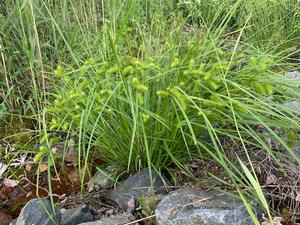New Moon Nurseries
Carex comosa
Bristly sedge, Longhair sedge
Native to North America
FIRST IMPRESSIONS: Carex comosa is a large tufted wetland sedge. The narrow leaves are lime green and shiny. In late spring triangular culms rise above the foliage to 5’ bearing large chartreuse bottlebrush shaped spikes. Attractive warm brown seed spikes follow. This bold sedge flourishes in sun or part sun in damp or wet sites. Plants prosper in difficult wet mucky soils or even in shallow water.
HABITAT & HARDINESS: Carex comosa is native to the southern Canadian provinces of Quebec, Ontario and British Columbia. Plants occur through much of the eastern and parts of the mid-western and western United States. The greatest distribution is in the northeastern U. S. and in states that border the Great Lakes.
Plants are indigenous to swamps, seeps, freshwater tidal marshes, bogs, pond and lake margins, wet meadows and ditches.
Hardy from USDA Zones 3-10.
PLANT DESCRIPTION: Carex comosa is a vigorous clump forming sedge with a fountain like habit.
The arching glossy leaves are about 18-36” long, almost 3/4” wide and folded into a triangular or keel shape.
In late spring sharply angular culms rise above the basal foliage. The fertile culms produce leaves, several bristly dangling pistillate flower spikelets and a terminal staminate spikelet.
The pistillate spikelets are unique and showy because of their large size, vivid green color and bristly or bottlebrush vestiture. The surface characteristics are due to distinctive curved teeth on the plump perigynia sacs that enclose the female flower parts.
Mature seedheads are attractive and light brown with distinct bristly appendages on the perigynia that now encloses the seeds.
CULTURAL & MAINTENANCE NEEDS: Carex comosa thrives in sunny moist or wet sites. It is essential that planting sites remain moist.
Plants are pest resistant and unpalatable to deer and other herbivores.
LANDSCAPE USES: Carex comosa is valuable for Wetland Restoration and soil retention in Bioswales and drainage ditches. This sedge is useful in Wet Meadows and is a good component for a Grouping or Mass Planting. Plants provide Erosion Control and Attractive Seedheads and are appropriate for Deer Resistant Plantings, Low Maintenance Plantings, Rain Gardens, Water Gardens and Wildlife Gardens.
COMPANION & UNDERSTUDY PLANTS: Try pairing plants with Asclepias incarnata, Lobelia cardinalis, Iris versicolor, Iris virginica and Juncus effusus.
Carex hystericina and Carex crinita are similar in appearance and cultural needs and can be substituted if needed.
TRIVIA: Carex comosa and other wetland sedges host caterpillars of Eyed Brown Butterflies and several species of Skippers and moths. Many wetland birds feed on the seed. The Sedge Wren feeds and nests in sites dominated by wetland sedges.
The perigynium is a distinguishing feature of Carex spp. This is a bag-like bract that encloses the pistillate flowers. The sac-like structure persists after fertilization and surrounds the resulting fruit which is a one seeded achene. The perigynia of Carex comosa have unique large curved teeth on the beak. The teeth cause the spikelet to feel like velcro. The related C. hystericina has shorter straight teeth. A third wetland species, C. crinita seems to be bristly but on close inspection the spikelet scales rather than the perigynia have the teeth.
Height:
2-3 FeetSpread:
18-36 inSpacing:
18-24 inUSDA Hardiness Zone:
3-10Bloom Color:
Brown, GreenCarex comosa Characteristics
Exposure
- Full Sun to Partial Shade
Flowering Months
- July
- August
Grass Season
- Cool Season Grass
Soil Moisture Preference
- Wet to Moist
Interesting Notes:
For more information on this plant, visit the USDA PLANTS Database: http://plants.usda.gov/java/profile?symbol=CACO8
